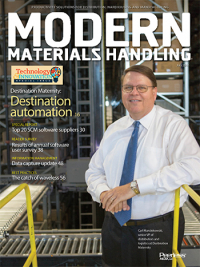Lift Truck Tips: Thin margins drive narrow aisles
To meet demands for dense storage, minimal labor and efficient equipment, even narrow aisle solution providers are sharpening their pencils.
Latest Material Handling News
Overlooked no more: The importance of lift truck inspections Lithium transition: It’s all about the outcomes Safety for automatic guided vehicle (AGV) environments Assessing the move to lithium Leasing’s fleet management upside More Lift Truck TipsWithin the past decade, the exponential increase in order complexity and the need for storage density have driven adoption of narrow aisle storage systems and the equipment that supports them. Advances in related technologies have been so significant that “narrow aisle” doesn’t quite mean the same thing as it did 5 or 20 years ago, according to Lou Micheletto, manager of integrated solutions for Hyster. Micheletto has been in the industry for 40 years and says heights are higher and speeds are speedier.
“I thought 400 inches would be as tall as a lift truck mast would ever get, now we have them going to 660 inches,” Micheletto says. “As for speed, we used to accept 60 feet per minute, and now 130 feet per minute is more the rule than the exception.”
Order sizes changed, from full pallet loads down to eaches. Equipment has changed, from primarily three- and fourwheel sit-downs and reach trucks to reaches for tall locations, turrets for intermediate heights, and end- or center-riders for case picking. What used to be 7-foot shelving is now 30-foot rack supported by turret trucks. What used to be 10,000 square feet allocated to warehousing is now down to 3,000 as the remaining space is given back to manufacturing.
The growth and evolution of narrow aisle applications also benefit from more advanced software and the key performance indicators (KPI) it enables. In the past, Micheletto says product entering the warehouse could go to any slot without much thought of how it would eventually be accessed or moved later. Today, thin margins drive operations to remove every unnecessary step or movement and slotting the fastest-moving items closest to the door.
“Your KPI 20 years ago was a visual of the dock. If something was left at the end of the day, you didn’t meet your goals, but you didn’t know why,” Micheletto says. “Now you can see real-time pick rates per hour for cases and eaches, broken down to the smallest level to find where any problem resides. There used to be a lot of small problems in the DC and people used to accept them. Not any more, since one small problem can cost thousands or hundreds of thousands of dollars.”
Safety is top of mind throughout every facility, but the precision and control of narrow aisle technologies can allow operations to add strong additional layers of operator safety. Unlike spoken and posted rules, programmed equipment behaviors can ensure safe operation. In addition to automatic braking and speed control in aisles, systems can prevent an operator from exiting into a pedestrian lane, for example, and the same technology can limit access to isolated product in pharmaceutical or food environments. Overhead obstacles can be similarly avoided with pre-programmed settings, RFID or proximity sensors.
“Going forward, self-guided technologies will change the way the game is played,” Micheletto says. “There’s no reason a human has to travel across a 1-million-square-foot facility just to transport goods. I’ve been really surprised at the demands of the market. I thought we would end up with a half dozen people excited to chat about self-guided technologies, and it turned out to be more than 100.”

Article Topics
Lift Truck Tips News & Resources
Overlooked no more: The importance of lift truck inspections Lithium transition: It’s all about the outcomes Safety for automatic guided vehicle (AGV) environments Assessing the move to lithium Leasing’s fleet management upside Managing for lift truck operator safety Narrow aisle success: Think systems, then trucks More Lift Truck TipsLatest in Materials Handling
Registration open for Pack Expo International 2024 Walmart chooses Swisslog AS/RS and software for third milk processing facility NetLogistik partners with Vuzix subsidiary Moviynt to offer mobility solutions for warehouses Materials Handling Robotics: The new world of heterogeneous robotic integration BSLBATT is looking for new distributors and resellers worldwide Lucas Watson appointed CSO for Körber’s Parcel Logistics business in North America Hyster recognizes Dealers of Distinction for 2023 More Materials HandlingAbout the Author
Subscribe to Materials Handling Magazine

Find out what the world's most innovative companies are doing to improve productivity in their plants and distribution centers.
Start your FREE subscription today.
April 2024 Modern Materials Handling

Latest Resources











